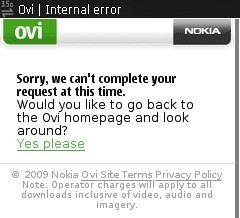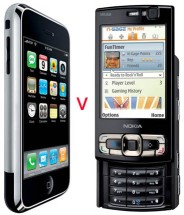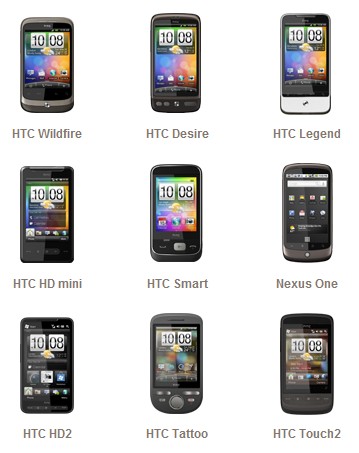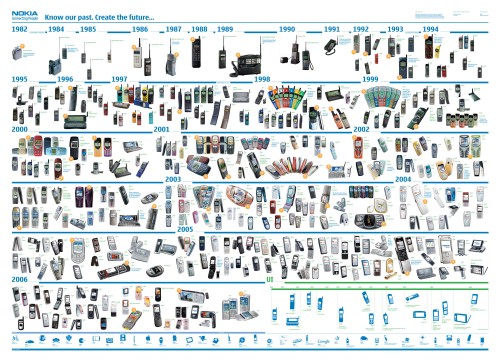If you’ve read my previous blog post about my personal handset history, you will have noticed that I have owned quite a few Nokia mobile phones in the past. You may also notice that the last one was from 2006. Not that it’s been a purely conscious decision to avoid Nokia for the past years, rather my current employer has been biased towards HTC and Windows Mobile (lately they’ve also given up on WM6, but that’s another story). My first mobile device that I paid with my own hard earned cash since the 2005 purchase of Nokia 6670 w/ Symbian S60 was a Samsung Galaxy Spica with Google’s Android OS. Did I consider buying a Nokia? Quite honestly, no, and I don’t think I would in the near future, as I’ve grown to be more and more pessimistic about the chances of the Finnish mobile giant being able to reclaim the leader position it once had.
Back when mobile phones were all about hardware, radio technology, silicon chips and plastic casing design, Nokia kicked everyone’s ass and it was a proud time to be a Finn (also a Nokia employee for a while). That time period was around one decade ago. I guess you could compare it to the 80’s when personal computers were still a messy playground with tens of competing manufacturers pushing their hardware+software packages to consumers, and Commodore building a comfortable lead with their C64 killer product. We all know where Commodore is today, or more specifically, most of us have absolutely no idea of where they are. Since those early days we’ve moved on quite a bit and everyone’s using either Windows or Linux on very generic hardware (apart from the crowd who choose to pay for the Apple/OSX device lock-in). That, in my opinion, is where we have been moving towards im the mobile phone markets ever since 2007 and the release of the iPhone. Nowadays we carry just big screens with us, either with or without a slider qwerty keyboard, and that’s pretty much how exciting the hardware part gets. Take a look at the HTC product catalog if you don’t believe me.
How is Nokia doing in this brave new mobile world? Not too well. Sure, they’ve got as many devices on their product catalog as ever and they completely own the non-smartphone market in developing countries. But do they really live up to the promises of their product marketing department or, more importantly, the expectations of their most loyal customers, their advocates? Well, you be the judge. Here’s one example of how a N97 customer felt after his purchase:
Now here’s the piece of news that originally inspired my own blog post: Symbian-Guru.com is over. I strongly encourage you to read through what Ricky and Rita have written down as the epitaph of their site, as this reads much like an epitaph of Nokia and Symbian that wouldn’t of course be published like this. Some key points from their writing could be summarized as follows:
- The gap between promises/expectations and product reality has grown unacceptable
- Developers have abandoned the Nokia platform long ago and now all hope lies on Nokia’s internal software development efforts
- Nokia’s own services are all hype and no content, as not even the company’s employees are committed to using them
- “Open source” in the context of Symbian is a meaningless buzzword, when no one is interested in the source in the first place
- Waving the Nokia/Symbian flag has become too embarrassing in the US market due to lack of visible marketing support from Nokia
As a sort of a CRM practioneer with some little insight on what customer relationships mean to a company, I would now like to produce the following quote from my very own words:
When you betray your most loyal customers and they call it a day, the game is over.
The emotions described in the Symbian-Guru.com post are the cornerstones of a successful company, except that now the stones have been turned and there is nothing to build on anymore. It is no longer a case of doing minor adjustments to product offering or shifting the focus of marking communication – we’re far beyond that by now. Of course the biggest mobile device manufacturer in the world could never publicly admit such a deep crisis, but the most important customers know it already. From observing the market reactions of the early adopter crowd, everyone who is seriously looking for proper smartphone functionality from the handset that they carry around with themselves is going either for iPhone or Android. It’s hardly a secret to anyone, rather it’s plain and obvious. That’s what I’ve done and I’m sure many others will follow.
There will certainly be a big enough market outside the world of smartphones and “smart” (geek) users to ensure that Nokia can keep generating billions of € worth of sales, which the stock market analysts can delve into and speculate future revenue trends by analysing how much more the company can squeeze out of it’s superior supply chain. However, it will not be the market that will attract the interest of those people who are building the new application ecosystems on top of the device manufacturer’s offering. They will be following the iPhone crowd, where all the action is. Where new markets emerge.
 If the old world of mobile phones was all about radio technology and hardware manufacturing, then the new world of mobile devices is focused around the services enabled by the hardware. This is of course not a surprise for Nokia, who have been continuously declaring their internal transformation to a service oriented company. Nokia have been making bold moves on the services front, by offering free navigation (after acquiring Navteq for $ 8 billion) and low cost packages for Comes With Music subscriptions to a semi-endless music catalog (something Spotify currently charges € 10 / month for mobile users) on their mid category products. Sure, these offerings do have lots of potential value to the customer, but upon a closer look they don’t necessarily have anything to do with the ability of building attractive mobile solutions that the users would like to use (as many Ovi users would probably agree). It is just built on external content, which Nokia is presumably using as a heavy loss leader product to get people hooked on buying the familiar hardware that the company actually physically develops and manufacures. There is basically nothing in this strategy that Microsoft, Google or Apple could not imitate if they wanted to. The difference is that neither Apple nor Google need to imitate it due to the success of their own unique strategies, and Microsoft can afford not to compete immediately but can rather attack a maturing market later on, since that is where they’ve always excelled at (and Windows Phone 7 looks to support this strategy).
If the old world of mobile phones was all about radio technology and hardware manufacturing, then the new world of mobile devices is focused around the services enabled by the hardware. This is of course not a surprise for Nokia, who have been continuously declaring their internal transformation to a service oriented company. Nokia have been making bold moves on the services front, by offering free navigation (after acquiring Navteq for $ 8 billion) and low cost packages for Comes With Music subscriptions to a semi-endless music catalog (something Spotify currently charges € 10 / month for mobile users) on their mid category products. Sure, these offerings do have lots of potential value to the customer, but upon a closer look they don’t necessarily have anything to do with the ability of building attractive mobile solutions that the users would like to use (as many Ovi users would probably agree). It is just built on external content, which Nokia is presumably using as a heavy loss leader product to get people hooked on buying the familiar hardware that the company actually physically develops and manufacures. There is basically nothing in this strategy that Microsoft, Google or Apple could not imitate if they wanted to. The difference is that neither Apple nor Google need to imitate it due to the success of their own unique strategies, and Microsoft can afford not to compete immediately but can rather attack a maturing market later on, since that is where they’ve always excelled at (and Windows Phone 7 looks to support this strategy).
 Was N95 perhaps the last real flagship from Nokia? While there were many people willing to use it as the yardstick to play down the signifigance of Apple’s first iPhone offering, I think the underlying problems in the Nokia/Symbian camp were already building up at that time, regardless of the fact that N95 was a commercial success. A high number of complaints on software bugs and general lack of the kind of high-end feel expected from a flagship product could retrospectively be interpreted as signals that Nokia’s existing method of developing new high-end products was reaching the end of its lifecycle; a point where optimising the existing process no longer delivers significant improvements, but where you need to invent a whole new process instead.
Was N95 perhaps the last real flagship from Nokia? While there were many people willing to use it as the yardstick to play down the signifigance of Apple’s first iPhone offering, I think the underlying problems in the Nokia/Symbian camp were already building up at that time, regardless of the fact that N95 was a commercial success. A high number of complaints on software bugs and general lack of the kind of high-end feel expected from a flagship product could retrospectively be interpreted as signals that Nokia’s existing method of developing new high-end products was reaching the end of its lifecycle; a point where optimising the existing process no longer delivers significant improvements, but where you need to invent a whole new process instead.
How far do you then have to go to find a big flagship product from Nokia’s product catalog? Something that packed a true punch, like the iPhone did? Nokia 7650 from 2002 perhaps? The setting is of course completely different from Apple, who entered a new market, but the question still has to be valid. If you only deliver lots of good products but no single great one, then why should I buy from you? The picture below is a beautiful collage from the Nokia product catalog, featuring each and every mobile phone they have ever made between the years of 1982 and 2006. The number of new product innovations and dominant mobile phones of their time included in this serving is just awesome. The only problem is that there doesn’t seem to be a system in place that would keep producing the same kind of “wow” results in the new world we are living. Nokia has become a victim of its past success.
Acknowledging that all the market share you’ve achieved and the great products you’ve delivered over the years is now worthless might surely feel like an act of pure insanity at first. But if you could get yourself to admit it, wouldn’t that be the exact moment when the climb back up starts? If the game is over, just reboot (heck, remove the battery if you must) and start all over. If you can’t do that, then you might as well consider it the end of your world. We don’t need an N8 from Nokia, or Symbian^4, or statements from Anssi Vanjoki about the company’s passion to reclaim smartphone leadership – we need a hard reset, and we need it yesterday.



True!
But have you considered the fact that nokia store have also good possibility for developers sell their apps.
Not the best ones, but iStore has too many apps to get your app to shown..
Android could be the future, but they have big problems too:
-Multiple devices and hardwares, how to develop app easily that does not crash 40% of the customers’ phones ?
-Adroid market leans towards free apps.. Not all of us want to make games and apps just for fun. And using adcontent seems like a wrong solution..
So at the moment, ovi store is strong
You’re correct that Android still has a long way to go. For example, the fact that Android Market paid apps are not available in some of the countries where the devices are sold (like Finland) is a handicap for the platform. Still, if you look at the very short history that Android has compared to Symbian, the pace at which the platform has been developing leads me to believe that the issues can and will be addressed as a part of the natural evolution of Android. The bigger the established set of devices and apps out there grows, the more challenges there will be in the maintenance/compatibility aspect of Android as a platform, but that is a positive problem to have.
While Nokia certainly has a huge potential market in its existing (and possibly brand loyal) user base in the developing world, the question remains that are these the people who will actually be purchasing apps to their mobiles within the next couple of years? The path I’m seeing is that many users who are ready to take the big step and start installing apps on their “phones” will first ditch their old Symbian device and replace it with iPhone/Android, then start exploring what apps there are out there.
I myself have never used a Nokia device during the Ovi era that started in late 2007, so I’m relying on hearsay and media coverage when forming my opinion of the service. The impression I have of Ovi is that it has consistently delivered a disappointing user experience and failed to meet the expectations of people who wanted to give it a shot. Similarly, I’ve never owned an Apple device, but the word on the street about the iPhone App Store experience is the complete opposite of Ovi Store.
Image is everything, and the image nowadays is largely created by the user and developer communities, not dictated by the marketing agencies. It may well be that this change in customer behaviour has also been one of the reasons why Nokia’s previously winning formula is no longer producing the results expected from the mobile phone market leader.